After the summer break, September got off to an early start with the VI International Conference on Managing Quality in Food Chains held at Cranfield University on 2 - 5 September. Over 150 delegates from over 40 countries attended. The conference was held in partnership with the International Society for Horticultural Science.
On 20 September members of the group assembled for our Annual General Meeting followed by the presentation of the 2013 David Miller Bursary Awards. This year's winners, Amanda Livermore from Reading University and Clive Lundquist from Bristol University and the Royal Botanic Gardens, Kew were presented with their awards by Chris Moncrieff, Production Director of one of our sponsors, VHB Herbs. In addition to a £250 grant towards their travel plans they receive three years' Friends Membership of the Eden Project. We were also joined by one of last year's winners, Emma Bennett. Both Amanda and Emma have agreed to join our Group Committee. We welcome them and look forward to the input from their younger minds.
On 16 October we will be joining the Professional Horticulture Group South West for a visit to Mapperton Gardens near Bridport, in Dorset. Those wishing to attend should contact John Lockwood.
In November SCI will be holding its annual Members' Forum on 19 November. Owing to the refurbishment at Belgrave Square this will be held at the Royal College of Surgeons in Lincoln's Inn Fields, London.
Editor
David Miller Travel Bursary Awards
On 20 October we were pleased to welcome this year's two winners of the David Miller Travel Bursary Award, Amanda Livermore and Clive Lundquist, to our Annual General Meeting. They were presented with certificates to mark their award by Chris Moncreiff, Production Director of VHB Herbs, one of the awards sponsors. Afterwards they gave a presentation on their work and the purpose to which their award will be put. We were also joined by one of last year's winners, Emma Bennett, who also gave us an update on her work. A report on Emma's award can be found here. Amanda's and Clive's reports will appear in due course.

Amanda is doing her PhD at Reading University supported by the Horticultural Development Company. She is searching for bio-control agents occurring naturally on the surfaces of UK plants that are pathogenic to aphids. Predatory and parasitic insects are already widely used to control aphids. However, when populations are attacked by these insects nearby individuals may respond by either falling off the plant or producing winged offspring that can fly away.
Either way the population is triggered to spread - an undesirable effect. Pathogenic bacteria and fungi do not trigger a similar response so Amanda has been isolating samples from the environment and then identifying and characterising them as well as screening them for aphid toxicity. She has identified several strains that have good pathogenicity against aphids and her next step is to ensure that these pathogens have no effect on other insects, particularly bees. To this end she will be using her David Miller Bursary Award to travel to a laboratory in Tunisia which specialises in screening bees and has the developed specific techniques which will be used to test Amanda's selected strains. The picture shows Amanda receiving her certificate from Chris Moncrieff.

Clive is doing his PhD at Bristol University but is conducting his studies in the Jodrell Laboratory at the Royal Botanic Garden, Kew. He is investigating the occurrence and causes of iridescence in plants.
Iridescence is caused by multiple reflections from semi-transparent layers. Two morphological features have been found to create iridescence in plants. Firstly the multiple layers of cellulose in the cell wall and secondly from modified chloroplasts called iridoplasts in which the alignment of the thylakoids in the grana provides the reflective surfaces. It has found it in clubmosses (Selaginella sp.), ferns (Trichomanes elegans and Elaphoglossum sp.), rushes (Mapania caudata) and others.
Clive has now added the first orchid (Masdevallia caesia) to the list and is finding it in all sorts of new genera and families. Iridescence tends to be a feature of plants growing in deep shade where growth is slow so one can speculate that it may be an adaptation to discourage herbivores. The real reason is as yet unknown but Clive expects photoprotection to be the likely purpose since sudden exposure to strong light could be damaging to these slow growing plants. As dark tropical forests are the best place to find these plants, Clive plans to use his David Miller Travel Bursary to help fund a trip to Borneo, one of the best locations to find iridescent plants. The picture shows Clive receiving his certificate from Chris Moncrieff.

Emma is just finishing her PhD at Reading University. She won her David Miller Travel Bursary in 2012 and used it to travel to Massachusetts, USA to attend the Gordon Research Conference on Plant Senescence and to then travel on to the Genomics Centre at UC Davis, California in order to further her understanding of plant senescence and its relationship to food security (read report).
In her final year she has been continuing to examine the impact of nutrition on seed development and its interaction with plant density and plant structure. For example she has found a direct correlation between stem diameter and seed yield and an inverse relation between seed number and seed size as well as lipid content. She has now written up her thesis to highlight the importance of these factors in relation to global food security issues.
Avon Bulbs
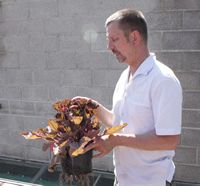
Although much of its turnover is in mainstays such as tulip and narcissus, these are bought in. This enables the nursery to concentrate on the more unusual bulbs in which they specialise. Our tour, which had been organised by the Professional Horticulture Group South West, started in the essential bulb store cum pack-house, the hub of the business, where our guide, Brian Ellis, first outlined the business. He then led us through the greenhouse and polytunnels where much of the propagation is undertaken. Here a magnificent display of Canna iridifolia caught everyone's eye. Here too were some specialist non-bulbous plants are also propagated including an interesting purple plantain, Plantago major rosenstolz, shown in our illustration.
Our tour then took us through a woodland area, the main propagation area for snowdrops and aconites, before reaching the main bulb beds. Our visit coincided with the peak of the hot summer weather so many of the plants were stressed, but also very late in their flowering following the long cold spring the country had endured. As a result species like the many Agapanthus varieties should have been in full flower were still in bud. However, some of the alliums were at their best including a bed of Allium angulosum. This pale lilac species from Eastern Russia is grown in Siberia as Mouse Garlic and salted for winter use. The strain we examined seems to be sterile, although like many alliums it propagates readily under the soil.
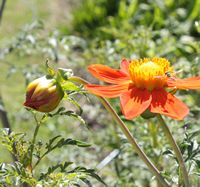
Moving on we were intrigued by the companies raised beds constructed from second-hand Armco barriers - unusual but very effective. Among the other unusual non-bulbous plants growing here were Ammi Majus, an umbelifer with lacy white flowers like a more delicate form of cow parsley, and a purple honesty Linaria annua Chedglow.
Their selling, as is customary with bulb producers, is organised into two distinct seasons. An autumn season when the many familiar spring bulbs in all their great variety are sold and a spring season when the summer and autumn flowering bulbs are sold. This entails the production of two catalogues each year, a task now being simplified by move towards more and more online buying.
Peter Grimbly
Plant of the Month
Acer rubrum 'Schlesingeri', red maple, Sapindaceae
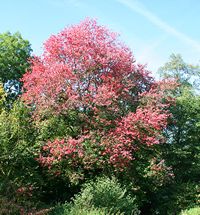
Acer is a temperate genus of trees and shrubs Some are important for timber, some for maple syrup production and many are cultivated for their ornamental beauty, including this selection of red maple. Acer rubrum (pictured right ) is a free growing, ultimately large tree from North America including Canada.
This selection was first noticed by Charles Sargent, Director of the Arnold Arboretum, growing in the garden of his neighbour, Mr Barthold Schlesinger in Brookline, Massachusetts. In 1888, budwood material was grafted to stock at the Arboretum and the resulting trees planted into the arboretum where they remain today. However, it was via a nursery in Berlin that this cultivar first entered the ornamental trade. Sadly, the nursery ceased trading during World War II. Subsequently in 1951, the Arnold Arboretum once again distributed material to the nursery trade.
The stunning red colouration of the leaves in the autumn is due to the production of chemicals called anthocyanins formed whilst the leaves are in decline. The purpose of the anthocyanin production has caused much discussion but researchers have shown that plants with anthocyanin in the leaves had less nitrogen in them when the leaves fell - ie more nitrogen had been absorbed back into the trunk. This would give the plants a clear advantage in the following season with more nitrogen resources to draw on.
Alison Foster
Oxford Botanic Garden
Medicinal Plant of the Month
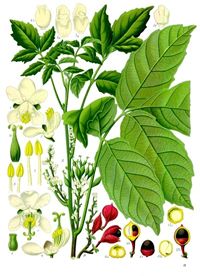
Sometimes you come across a plant and wonder how you have never heard of it before! Such was the case when twice in one day, this plant came to my attention. On reading the words caffeine, theobromine, fish-poison and alcohol, I felt I had to learn more…
Paullinia is a genus named by Linnaeus for Simon Paulli (1603-1680), a professor of anatomy, surgery and botany at Copenhagen. Documentation to support this is provided by Linnaeus himself in his Critica botanica no. 238 (1737). It is a genus of tropical American lianas (woody creepers/vines) with almost 200 species originating from there.
Paullinia cupana, (illustrated right) comes from the lower Amazon region and is cultivated in Brazil. Like others in the genus it has coiled tendrils and compound leaves. It also has inconspicuous yellow flowers and small, bright red fruits containing spherical brown seeds. The seeds have shiny dark spots on their tips which some say resemble eyes. There is a common association in the folklore and traditions of the Maués Indians of Brazil between guaraná seeds and human eyes. However, it is the seeds that contain the chemical that is of interest to all those caffeine addicts across the world. Guaraná paste contains a minimum of 3% caffeine (three to five times more caffeine than coffee) making it the most caffeine-rich of all products. In addition to the caffeine, the seeds contain a high concentration of phenolic substances including catechin, epicatechin and proanthocyanidins.

Incidentally, the seeds also contain theobromine (think chocolate) and other species in the genus are used as fish poisons. Along with cassava, the guaraná plant is used to make the principal alcohol of Mato Grosso (Brazilian state).
Alison Foster
Oxford Botanic Garden
News from our Associates
Commercial Horticultural Association


The Society of Biology responded to the inquiry on women in academic STEM careers. The inquiry sought to probe why the numbers of women in STEM academic careers decline further up the career ladder and, when women leave academia, what careers they transition into and the consequences of scientifically trained women applying their skills in different employment sectors. It also sought views on what universities and the higher education sector should do to retain women graduates and PhD students in academic careers and what role the Government should take in encouraging the retention of women in academic STEM careers.
Horticulture Industry News
For the very latest horticultural news follow us on Facebook,
Twitter, or
LinkedIn
Adaptable forests
Traditional advice to woodland owners advocates planting trees from local provenances because local trees are best adapted to local conditions. However, trees which are used to growing in warmer regions might be better adapted to our likely future climate, and the potential benefits of drawing from a broader genetic stock than the local area can provide are being increasingly recognised. Therefore planting trees from a wider range of UK sources might help, and research is under way to consider the implications of planting species which are native to the UK, but sourced from elsewhere in Europe. Forest Research have planted more than 3700 saplings including oak, ash, sweet chestnut and wild cherry on a Kent estate. As well as local sources, the saplings came from locations in northern France and central Italy.
New tool to help growers plan field margins
A web tool that helps growers choose the right seed mix for their field margins has been launched by the Horticultural Development Company (HDC) and Stockbridge Technology Centre (STC). Growers of horticultural crops face increasing production pressures, including the diminishing availability of crop protection products and the need to comply with environmental legislation. The Automated Field Margin tool helps combat these issues by proposing suitable seed mixes that encourage natural pest enemies, as well as farmland birds and pollinators, as part of an Integrated Pest Management (IPM) strategy.
Scaffolding is key to cell growth
Scientists have discovered an important mechanism in plant cells which regulates the direction that plant cells grow. Plant cells can expand to up to 1,000 times their original size, and the growth and shape of plant cells is determined by the direction of expansion. Key to this process is the distribution of cellulose.
A protein scaffold within the cell, called the microtubule network, dictates the organisation of cellulose in the wall by forming tracks which guide its placement. Previous work found that microtubules are organised into aligned configurations, with poorly aligned microtubules being cut away by an enzyme called katanin.
The researchers demonstrated that a protein called SPIRAL2 regulates where and when microtubule cutting occurs. Depending on the organisation of microtubule required by the plant SPR2 either remains stationary, preventing katanin cutting the microtubules, or is constantly moving along microtubules exposing areas for katanin to sever them and drive alignment. It is the first plant protein described that determine microtubule organisation by regulating where and when katanin cuts microtubules. More
A brand new organelle - the tannosome
Tannins are present in most vascular plants and serve diverse roles. They provide defence against herbivores and pathogens, and protection against UV radiation. Researchers have now described the detailed ultrastructure and morphology of the possible involvement of chloroplasts in the formation of tannin-forming structures in vascular plants. This resulted in the discovery of a new chloroplast-derived organelle, the tannosome.
These structures are formed by pearling of the thylakoids into 30 nm spheres, which are then encapsulated in a tannosome shuttle formed by budding from the chloroplast. The shuttle conveys numerous tannosomes through the cytoplasm towards the vacuole. Finally, shuttles aggregate into tannin accretions which are stored in the vacuole. The complete sequence of events described occurs in all studied vascular plants. More
Tarantula toxin to target insect pests
Researchers have found a natural component of Australian tarantula venom that is more potent against certain insect pests than existing chemical insecticides. They have identified a toxin known as OAIP-1 that is lethal if eaten by the cotton bollworm or termites which could be developed into an environmentally friendly insecticide. OAIP-1 is orally active, meaning insects just have to eat the toxin in order for it to work. Numerous insecticidal toxins have already been isolated from spider venom but very few of these have been tested to determine whether they are orally active, a vital property for an effective insecticide.
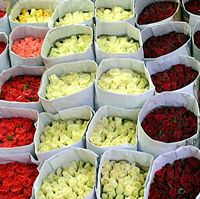
A shipping container holding roses from Mombasa, Kenya arrived in the Netherlands in good order. This pilot scheme demonstrated the feasibility of reducing CO2 emissions by 87% compared with the normal air freight used. Following an extended period of preparation including varietal selection, choice of packaging, and mapping out the supply chain, the first shipment proved successful.
The flowers were shipped by reefer (or refrigerated) container, in a supply chain which is refrigerated at every stage of the way over land and sea with the aim of achieving 90% economy in emissions of CO2, thereby demonstrating the feasibility of long-distance transport by water while maintaining the quality of the flowers. The realised reduction of 87% is a savings of 37,845 kg of CO2 - an amount equal to 100 holiday journeys in a new passenger car from Amsterdam to Barcelona and back.
Artificial egg made from plants
A radical 'artificial egg' has gone on sale in US supermarkets for the first time. Made from plants, it can replace eggs in everything from cakes to mayonnaise - without a chicken ever coming close to the production process. The idea was to find a mix of easy-to-grow plants that, when mixed together in the right way, replicate the taste, nutritional values and cooking properties of an egg. The final mix contains about 12 plants pre-selected, including a pea already widely grown in Canada and a bean from South Asia that is incredible in scrambled eggs. So far the team has perfected an egg substitute for mayonnaise, and one for cakes. More
Pests move north slowly
Hundreds of crop pests are advancing away from the tropics at a rate of nearly two miles a year. The most likely explanation for the trend is said to be climate change as rising temperatures make new habitats more inviting. Pest invasions driven by global warming have serious implications for agriculture and food security. British scientists studied data on the distribution of 612 crop pests collected over the past 50 years. They found an average shift towards the north and south poles of around 1.7 miles (2.7km) per year. Pests whose traditional homes were warmer regions near the equator were branching out to new locations they would have previously found too cold. More
Events Calendar
BCPC Congress
1 - 2 Oct, British Crop Production Council
Brighton, UK
South West Growers Show
2 Oct
Exeter, UK
New Technologies for Environment Control, Energy-saving and Crop Production in Greenhouse and Plant Factory
6 - 11 Oct, International Society for Horticultural Science
Jeju, Republic of Korea
Crop Breeding over 10,000 years; Lessons for current and future challenges
7 - 8 Oct, Association of Applied Biologists
Cambridge, UK
European Congress on Chestnut
9 - 12 Oct, International Society for Horticultural Science
Debrecen, Hungary
Medicinal Plants and Natural Products
14 - 16 Oct, International Society for Horticultural Science
Lima, Peru
IPM: Pushing Back the Frontiers
15 - 16 Oct, Association of Applied Biologists
Marston, UK
Asparagus Symposium
17 - 19 Oct, International Society for Horticultural Science
Nanchang, China
Organic Matter Management and Compost Use in Horticulture
20 - 25 Oct, International Society for Horticultural Science
Santiago, Chile
Eighth National Congress of Applied Entomology
21 - 25 Oct, University of Barcelona
Barcelona, Spain
Non-native Plants: A London Perspective
21 Oct, Gresham College
London, UK
Novel Technologies for Food & Nutrition
23 Oct, NanoKTN
London, UK
Cactus Pear and Cochineal
28 - 30 Oct, International Society for Horticultural Science
Palermo, Italy
Organic Greenhouse Horticulture
28 - 31 Oct, International Society for Horticultural Science
Avignon, France
Imported Plant Diseases
28 Oct, Gresham College
London, UK
Crop World Global
29 - 30 Oct, UBM
Amsterdam, The Netherlands
Fruit Culture and its Traditional Knowledge along Silk Road Countries
4 - 8 Nov, International Society for Horticultural Science
Tbilisi, Georgia
Fruits and Roots: A Celebration and Forward Look
6 - 7 Nov, Association of Applied Biologists
East Malling, UK
International Horticultural Trade Fair
6 - 9 Nov, HPP Exhibitions
Vijfhuizen, The Netherlands
Plant Breeding Congress
10 - 14 Nov
Antalya, Turkey
GroSouth
13 Nov, Roundstone Nurseries
Chichester, UK
BCPC Weed Review
14 Nov, British Crop Production Council
Rothamsted, UK
Pests and Natural Enemies in Fruit Crops
14 Nov, Royal Entomological Society and East Malling Research
East Malling, UK
Bacterial Canker of Kiwifruit
19 - 22 Nov, International Society for Horticultural Science
Mt Maunganui, New Zealand
Onion & Carrot Conference & Exhibition
20 - 21 Nov
Peterborough, UK
Farm Business Innovation
28 - 29 Nov, Prysm Media
London, UK
Positive Plant Microbial Interactions: Their role in maintaining sustainable and natural ecosystems
2 - 3 Dec, Association of Applied Biologists
Brigg, UK
Plant Genomes & Biotechnology: From Genes to Networks
4 Dec, Cold Spring Harbor Laboratory
Cold Spring Harbor, USA
Quality Management in Postharvest Systems
4 - 7 Dec, International Society for Horticultural Science
Vientiane, Laos
Advances in Nematology
10 Dec, Association of Applied Biologists
London, UK
Photo-Physiology Phenotyping Workshop
16 - 17 Dec, University of Essex
Colchester, UK
Rethinking Agricultural Systems in the UK
18 - 19 Dec, Association of Applied Biologists
Oxford, UK
If you would like to advertise a forthcoming event please contact. ester.monfort@soci.org
Horticulture Group Contact Details
For submitting ideas or to volunteer to be part of a committee or a group, please contact:
Chairman - Peter Grimbly
Meetings Secretary - Alison Foster
Minutes Secretary - Margaret Waddy
Newsletter co-ordinator - Sue Grimbly scihortigroup@btinternet.com
Group Contact - Ester Monfort Martinez, E: ester.monfort@soci.org T: +44(0)20 7598 1584
